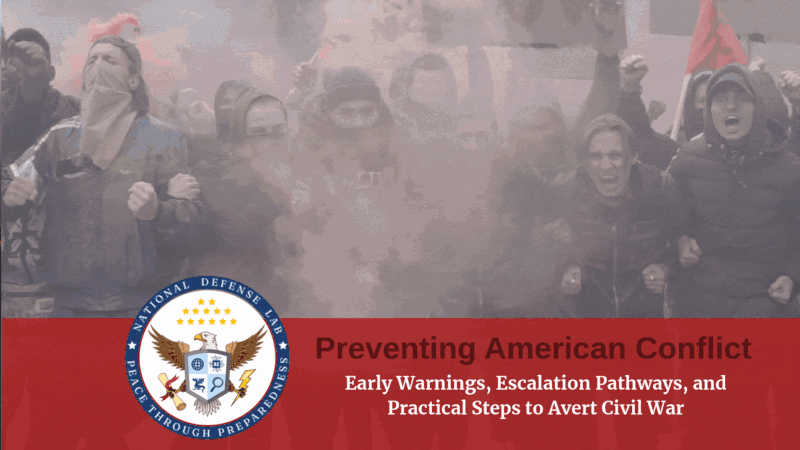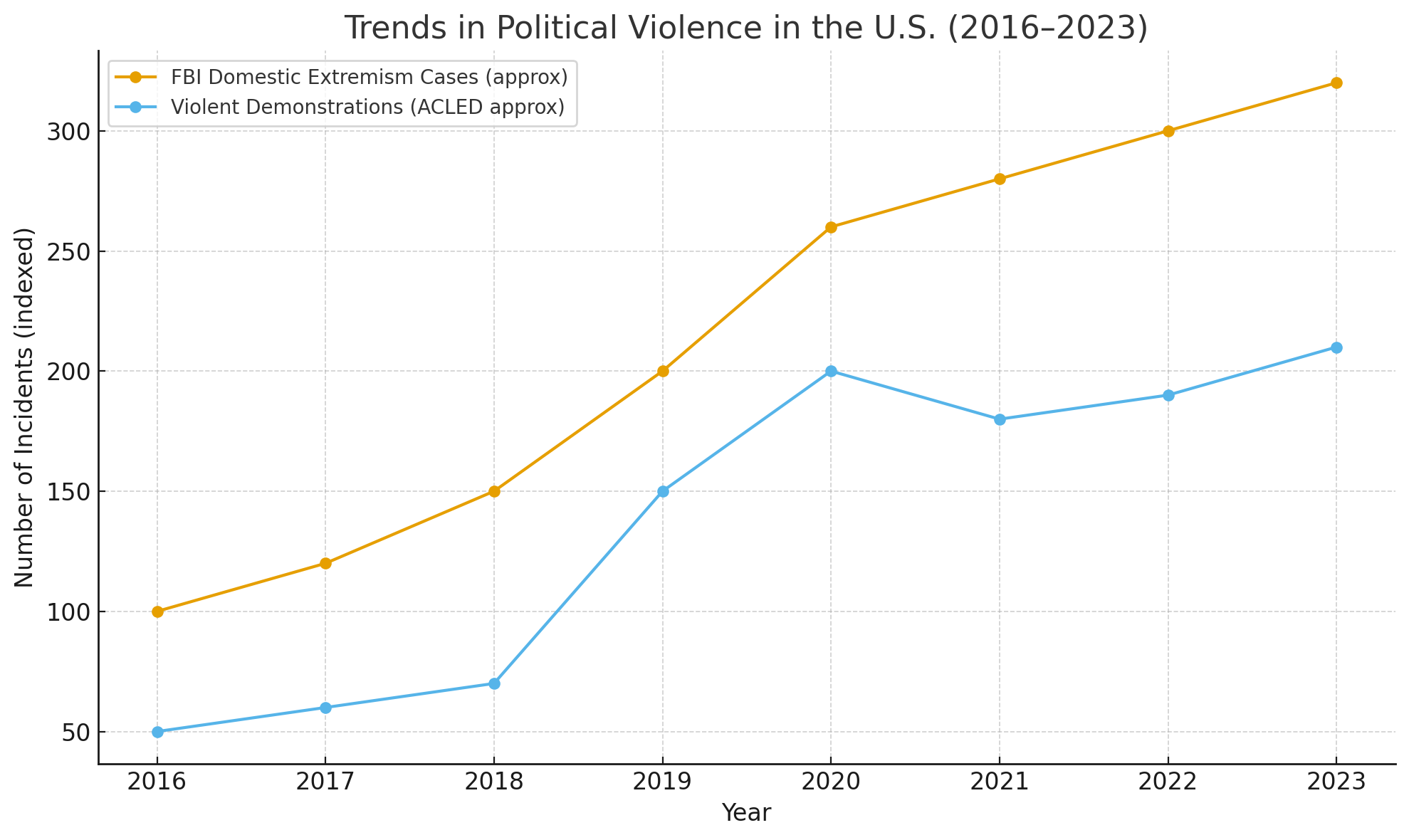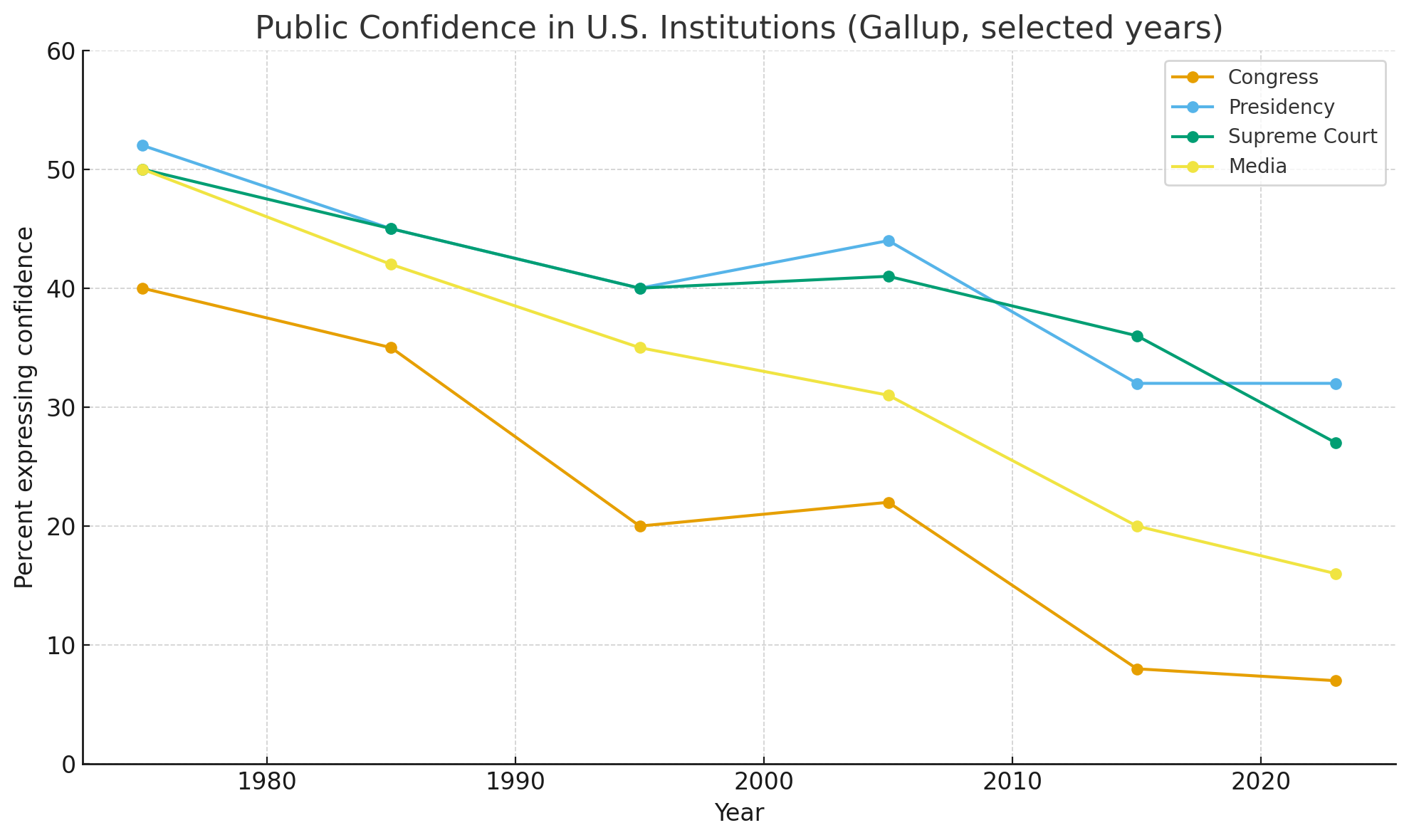Supercharge your defense operations with NDL solutions. Dive into a partnership that expands your team's cognitive reach. Ready to amplify your project's impact?
Preventing American Conflict: Early Warnings, Escalation Pathways, and Practical Steps to Avert Civil War

Acknowledgment
We want to thank Tim Cramer (@cramersez) for his upfront honesty and willingness to voice uncomfortable concerns about the trajectory of unrest in America (You can read his commentary here). His post captured the fears many share but few articulate. At National Defense Lab, we take such warnings seriously. Our mission is to go beyond alarm to provide frameworks, tools, and strategies that transform concern into prevention.
Executive Summary
Public anxiety about the possibility of civil war in the United States is at its highest level since the 1860s. Recent acts of political violence, incendiary rhetoric amplified by social media, and the increasing use of state power to target political opponents have raised legitimate questions about whether the country could slip into widespread, organized conflict.
This white paper argues that while the probability of a nationwide civil war remains low, the probability of localized and escalating political violence is real and growing. Using @cramersez’s recent post ^9 as a starting point, we explore the sequence of incidents, responses, and counter-responses that characterize America’s current crisis. We then analyze the structural thresholds that would need to be crossed for violence to tip into sustained civil conflict.
The critical task is prevention. The United States has the tools, knowledge, and institutions to avert civil war if early warning indicators are taken seriously and acted upon. National Defense Lab outlines practical projects, policy recommendations, and civic resilience strategies to reduce the risk of conflict and preserve democratic order.
1. Why Fears of Civil War Are Resurfacing
1.1 Escalating Political Violence
The FBI noted in 2022 that domestic violent extremism cases more than doubled between 2017 and 2021.^1 Data from the Armed Conflict Location and Event Data Project (ACLED) showed that in 2020, 93 percent of demonstrations in the United States were peaceful. Still, the remaining 7 percent represented the largest wave of violent demonstrations in decades.^2

What is different today is the speed of escalation. Each violent act is amplified online within minutes, spawning counter-reactions, workplace repercussions, and fresh grievances.
1.2 Social Media as Escalation Engine
Research shows that false information spreads faster and farther online than verified reporting.^3 Algorithmic amplification privileges outrage, mockery, and calls for retaliation. As @cramersez observed, memorials were vandalized and instantly broadcast. Employers responded to public doxxing campaigns. Retaliatory firings followed. Each step deepened polarization.
1.3 Erosion of Institutional Trust
Public trust in American institutions has collapsed. Gallup reported in 2023 that only 7 percent of Americans expressed confidence in Congress, 27 percent in the Supreme Court, and 32 percent in the presidency.^4 Pew Research Center found that trust in government remains near historic lows, with only about 20 percent of Americans saying they trust Washington to do what is right most of the time.^5

2. What Civil War Would Actually Require
Civil wars require structural thresholds:
-
Sustained Armed Mobilization.
-
Loss of Territorial Control.
-
Security Force Fragmentation.
-
Collapse of Political Mediation.
These conditions are not yet present. The United States faces rising violence and polarization, but not the systemic breakdowns that characterized 1861 or other modern civil wars.^6
3. Early Warning Indicators of Escalation
Drawing from RAND and ACLED studies, warning signs include:
-
Sharp increases in political assassinations or attempted assassinations.^7
-
Armed standoffs between militia groups and state authorities.
-
Demonstrations with violence consistently above 10 percent across multiple regions.^8
-
Mass defections in law enforcement or National Guard units.
-
Governors declaring repeated emergency powers in advance of protests.
-
Coordinated disinformation campaigns portraying violence as justified.^9
-
Viral calls to arms spreading across platforms such as X, Telegram, and TikTok.
4. Case Application: Lessons from the Kirk Timeline
The timeline outlined by @cramersez illustrates how escalation unfolds:
-
Trigger Event: Assassination.
-
Polarized Reaction: Celebration and outrage online.
-
Physical Targeting: Vigils and memorials vandalized.
-
Economic Punishment: Firings and doxxing.
-
Counter-Retaliation: Reverse firings from other employers.
-
Elite Amplification: Media figures mock or legitimize violence.
-
State Action: Government interventions politicize the moment.
-
Counter-Mobilization: Hashtags and campaigns escalate identity conflict.
Each step ratchets up division and narrows the off-ramps from violence.
5. Why Prevention Is Possible
Despite these risks, the United States still has resilience capacity. Civil wars are not inevitable. With early detection, transparency, and civic engagement, escalation can be contained.^10
6. Practical NDL Projects for Prevention
-
Rapid Research and Verification Hub: Counter misinformation by producing verified public incident dossiers.
-
Early Warning Dashboard: Fuse protest, crime, and social media data for escalation alerts.^11
-
Community Resilience Pilots: Local mediation programs to build trust and reduce violence.
-
Employer Best Practices Program: Protect against retaliatory firings that fuel grievance.
-
Law Enforcement and Guard Training: Reinforce nonpartisan professionalism to avoid fragmentation.
7. Policy Recommendations
-
Short-Term: National hotline for violent mobilization threats; transparency for social media takedown requests.
-
Medium-Term: Clarify limits on domestic terrorism designations; fund resilience programs.
-
Long-Term: Invest in civic education; establish resilience councils; create frameworks against foreign interference.^12
8. Ethical and Civil Liberties Guardrails
-
Privacy protections in all early warning systems.
-
Oversight boards with civil liberties advocates.
-
Transparent auditing of AI models for bias.
-
Interventions targeting escalation conditions, not ideology.^13
9. Conclusion: Turning Concern into Prevention
The United States is not destined for civil war. Civil wars require conditions that do not yet exist. What we face now is a dangerous cycle of political violence that could escalate if left unchecked. This can be prevented.
By building verification hubs, early warning systems, resilience pilots, employer programs, and professional training for security forces, America can defuse tensions. Policy reforms can institutionalize resilience.
Acknowledging risk is not alarmism. It is a responsibility. With vigilance, preparation, and a commitment to liberty, the nation can avert civil conflict and serve as a model of democratic resilience for the world.
Whitepaper Download
Podcast
Coming soon.
Source List
-
FBI. “Statement on Domestic Terrorism Threats.” Congressional Testimony, 2022. https://www.fbi.gov/news/testimony
-
ACLED. “Demonstrations in the United States, 2020.” https://acleddata.com/2020/09/03/demonstrations-in-the-united-states-2020/
-
Vosoughi, Soroush, Deb Roy, and Sinan Aral. “The Spread of True and False News Online.” Science 359, no. 6380 (2018): 1146–1151. https://doi.org/10.1126/science.aap9559
-
Gallup. “Confidence in Institutions 2023.” https://news.gallup.com/poll/508569/confidence-institutions-2023.aspx
-
Pew Research Center. “Public Trust in Government: 1958–2023.” https://www.pewresearch.org/politics/2023/05/08/public-trust-in-government-1958-2023/
-
Kalyvas, Stathis N. The Logic of Violence in Civil War. Cambridge University Press, 2006.
-
RAND Corporation. “Trends in Political Violence: A Framework for Early Warning.” https://www.rand.org/pubs/research_reports/RRA2237-1.html
-
ACLED. “US Crisis Monitor.” https://acleddata.com/special-projects/us-crisis-monitor/
-
Tucker, Joshua A., et al. Social Media, Political Polarization, and Political Disinformation. Hewlett Foundation, 2018. https://hewlett.org/library/social-media-political-polarization-and-political-disinformation-a-review-of-the-scientific-literature/
-
Chenoweth, Erica, and Maria J. Stephan. Why Civil Resistance Works: The Strategic Logic of Nonviolent Conflict. Columbia University Press, 2011.
-
National Academies of Sciences. Building Resilient Communities for National Security. Washington, DC: The National Academies Press, 2021. https://nap.nationalacademies.org/catalog/26215
-
Brennan Center for Justice. “Domestic Terrorism: Legal Issues and Policy Challenges.” https://www.brennancenter.org/our-work/research-reports/domestic-terrorism-legal-issues-and-policy-challenges
-
Congressional Research Service. Domestic Terrorism: An Overview. https://crsreports.congress.gov/
Tim Cramer (@CramerSez). “I haven't written a long-form piece in awhile… Civil Unrest: Is Civil War Imminent?” X (formerly Twitter), September 18, 2025. https://x.com/CramerSez/status/1968547585225814449.



